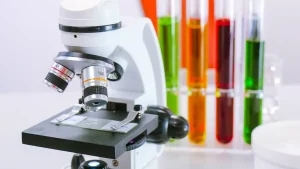
炭化ケイ素(SiC)コーティングの調製は、その高融点ともろさのために大きな課題を突きつけている。これらの問題は、加工と取り扱いの両方を複雑にしている。産業界では、以下のような耐久性のあるコーティングが求められている。 SiCコーティング そして TaCコーティング 過酷な環境に対応します。このような障害を克服することで、航空宇宙、エレクトロニクス、エネルギーシステムなどの用途において、性能、信頼性、寿命の向上を保証することができます。
要点
- 炭化ケイ素(SiC)コーティングは 作りにくい.高熱、特殊な工具、多くのエネルギーを必要とし、コストが上がる。
- SiCは脆いため、簡単に割れてしまう。そのため取り扱いが難しく、産業界はクラックを避けるために厳しいルールに従わなければならない。
- PECVDのような新しい方法 とALDは、コーティングをより良いものにするのに役立つ。旧来の技術の問題を解決し、均一性を向上させる。
SiCコーティングにおける材料の課題
融点が高く、エネルギー集約的な処理
炭化ケイ素(SiC)は、非常に優れた特性を示す。 高融点 これはシリコンの1414℃を大きく上回る。この特性はSiCを高温用途に理想的なものにしているが、同時にその加工に課題をもたらしている。SiCコーティング成膜に必要な高温は、高度な装置と多大なエネルギー投入を要求し、生産コストを増加させる。
| 素材 | 融点 (°C) |
|---|---|
| ケイ素 (Si) | 1414 |
| 炭化ケイ素(SiC) | 2700 |
メーカーは、必要な温度を達成するために、化学蒸着(CVD)などの技術に頼ることが多い。しかし、これらの方法は時間がかかり、欠陥を防ぐには精密な制御が必要である。SiC加工はエネルギーを大量に消費するため、費用対効果の高いソリューションを求める産業界でSiCが広く採用されるには、依然として重要な障壁となっている。
脆く、取り扱い中に割れる危険性がある。
SiCは本質的に脆いため、取り扱いや塗布の際に大きなリスクが生じます。わずかな機械的応力でも割れや欠けが生じ、コーティングの完全性が損なわれる可能性がある。この脆さは製造工程を複雑にし、部品は損傷を避けるために注意深く管理されなければならない。航空宇宙や電子機器にSiCコーティングを利用する産業は、こうしたリスクを軽減するために、厳格な取り扱いプロトコルを導入しなければなりません。SiCの望ましい特性を犠牲にすることなく靭性を高める方法を開発することは、依然として重要な研究分野である。
相制御に影響する化学反応性
高温処理中のSiCの化学反応は、相続性につながることができます。 SiCは環境の酸素または他の要素と反応し、不要なフェーズや不純物の形成をもたらす可能性があります。 これらの反応は、コーティングの微細構造を変更し、要求の厳しいアプリケーションの性能を減らすことができます。 精密な位相制御を実現するには、制御された雰囲気と高度な蒸着技術が必要です。 研究者は、化学反応を最小限にし、SiCコーティングの目的のプロパティを維持するために、革新的な方法を探求し続けています.
SiCコーティングにおけるプロセス関連の課題
CVDやPVDのような成膜技術の限界
化学気相成長法(CVD)と物理気相成長法(PVD)は、SiCコーティングの用途に広く用いられている。しかし、どちらの方法にも大きな限界があります。
- CVDは複雑な形状のコーティングに優れているが、非常に高い操作温度と危険な前駆体ガスの使用を必要とする。これらの要因はプロセスを複雑にし、安全上の懸念を増大させる。
- 一方、PVDは、特に複雑な表面や凹部で均一な被覆を達成するのに苦労する。また、成膜速度が遅いため生産効率が低下し、大規模な工業用途には不向きである。
- どちらの技術も、高真空システムなどの高価な装置を必要とするため、コストに敏感な産業にとっては、利用しやすさがさらに制限される。
これらの課題は、効率性、安全性、費用対効果のバランスがとれた代替蒸着技術の必要性を浮き彫りにしている。
高温要件と関連コスト
について 高温要件 siCコーティングは、生産コストを大幅に削減します。 1000°を超えるCVD必殺の温度のような技術 適切な付着およびコーティングの質を保障するC。 このような極端な条件を維持するには、高度な熱システムと実質的なエネルギー入力が必要です。 運用費を増加させるだけでなく、SiCコーティング生産のスケーラビリティを制限します。 業界は、材料の性能特性を維持しながら温度要求を減らすために革新的な方法に投資しなければなりません.
均一性と正確な厚みを実現
SiCコーティングの性能には、均一性と正確な膜厚が不可欠です。これらの品質を達成するには、欠陥のない緻密な層を形成できる高度なクラッディング技術が必要です。コーティング工程における膜厚分布の制御は、依然として重要な課題です。マグネトロンスパッタリングPVDとコンピューター支援による均一性調整などの最近の進歩が有望視されている。このアプローチは、低温で動作し、コーティングの密着性と密度を高め、一貫した品質を達成する上で重要な問題のいくつかに対処する。
SiCコーティングにおける品質管理の問題
表面欠陥と気孔率の懸念
表面欠陥および気孔率はSiCのコーティングの性能に著しく影響を与えます。 これらの不完全性材料の流れか不十分なプロセス制御による沈殿物プロセスの間に頻繁に起こります。 気孔率は、特に、コーティングを貫通するガスや液体の経路を作成し、腐食または熱抵抗を削減します。 ひびや不均等な質感などの表面欠陥、コーティングの構造的完全性と美的魅力を妥協します。 電子顕微鏡検査(SEM)および非破壊検査(NDT)のスキャンを含む高度な検査技術は、これらの問題を特定し、対処するのに役立ちます。 製造業者は欠陥を最小にし、密で、均一コーティングを保障するために沈殿物変数を精製しなければなりません.
多様な基材との接着問題
接着は、以下のような重要な課題である。 SiCコーティング を様々な基材に塗布することができる。塗膜と基材との熱膨張係数の違いは、しばしば熱応力下での剥離や層間剥離につながる。この問題は、金属、セラミック、複合材料などの用途で顕著になります。密着性を向上させるため、メーカーはグリットブラストやプラズマエッチングなどの表面処理を施し、基材の粗さを高めている。さらに、中間膜や接合剤を使用することで、基材とSiCコーティングの間に緩やかな移行を作り出し、応力集中を減らして全体的な密着性を向上させることができます。
過酷な条件下での耐久性を確保
SiCコーティングは、高温、腐食性化学物質、機械的摩耗など、過酷な環境にさらされることが多い。このような条件下での耐久性を確保するには、厳格な品質管理対策が必要です。熱サイクル試験、耐腐食性評価、摩耗試験は、次のような場合に不可欠です。 コーティングの性能の評価. . 添加剤や添加剤を組み込むなどの材料組成物のイノベーション、劣化に対するコーティングの耐性を高めます。 これらの耐久性の課題に対応することで、SiCコーティングの寿命を延ばし、要求の厳しい用途での信頼性を向上させることができます.
SiCコーティングの課題に対する進歩とソリューション
新たな成膜技術
革新的な成膜方法 は、SiC コーティングの調製を一変させている。プラズマエンハンスト化学気相成長法(PECVD)や原子層堆積法(ALD)といった技術は、コーティングの膜厚と均一性の制御を向上させます。PECVDは、従来のCVDに比べて低温で動作するため、エネルギー消費を抑え、基板への熱ストレスを最小限に抑えることができる。一方、ALDは、原子レベルの精密な制御により、超薄膜でコンフォーマルなコーティングを形成することに優れている。これらの進歩は、従来の方法の限界に対処し、SiCコーティング・プロセスをより効率的で産業用途に拡張可能なものにしている。
ヒント ALDのような新技術は、複雑な形状やマイクロエレクトロニクス部品のコーティングに特に有用である。
特性を向上させる添加剤の配合
研究者たちは 添加物の使用 SiCコーティングの機械的特性と熱的特性を向上させる。ホウ素やアルミニウムなどの添加剤は、靭性を高め、脆さを減らし、耐酸化性を向上させます。これらの元素はSiCマトリックスと一体化し、過酷な条件下でも耐えることのできる、より堅牢なコーティングを作り出します。さらに、ドーパントはSiCコーティングの導電性を調整し、電子機器やエネルギーシステムへの応用を拡大することができる。このアプローチは、コア材料を変えることなく性能を最適化するコスト効率の高い方法を提供する。
品質保証のための高度な試験方法
品質保証は、SiCコーティングの信頼性を確保するために重要な役割を果たしています。 X線回折(XRD)およびラマン分光を含む高度な試験方法により、製造業者はコーティングの結晶構造を分析し、フェーズ不純物を検出することができます。 超音波テストおよび熱画像のような非破壊的なテスト(NDT)の技術は、材料を損なうことなく表面の欠陥および気孔率を識別するのを助けます。 これらのツールは、コーティングの品質の正確な監視を可能にし、耐久性と性能の要求環境を保証します.
注: 厳格なテスト・プロトコルを導入することで、航空宇宙やエネルギー・システムのような重要度の高いアプリケーションにおける故障のリスクを低減することができる。
SiCコーティングの調製は、高コスト、技術的制限、規制上のハードルなど、大きな課題に直面している。
| 方法 | 課題 |
|---|---|
| 化学蒸着 | 可燃性前駆体による危険性、低い材料利用率、高いコスト。 |
| 物理蒸着 | 均一性を得るのが難しい、蒸着速度が遅い、設備コストが高い。 |
| スプレー技術 | 接着力が弱い、均一性が悪い、塗膜が薄い、耐酸化性が低い。 |
これらの障壁を克服するためには、イノベーションが不可欠であることに変わりはない。新しい技術と先端材料は、コストを削減し、性能を向上させることができる。SiCコーティングの用途を全産業に拡大するためには、認知度の向上、技術的問題への対処、環境基準の遵守の確保に今後の取り組みが集中すべきである。
注: 絶え間ない技術革新により、SiCコーティングは代替材料に対する競争力を維持しています。
よくあるご質問
SiCコーティングが過酷な環境に適している理由は?
SiCコーティングは、卓越した熱安定性、耐薬品性、機械的強度を提供します。これらの特性により、高温、腐食性、摩耗の激しい用途に最適です。
SiCコーティングの均一性達成はなぜ難しいのか?
均一性を保つには、蒸着パラメーターを正確に制御する必要があります。材料の流れや温度にばらつきがあると、厚みが不均一になり、性能や耐久性に影響します。
添加剤はどのようにしてSiCコーティングの特性を向上させるのか?
ブロンのような添加剤は靭性および酸化抵抗を高めます。 SiCのマトリックスに統合し、コーティングのコア特性を損なうことなく、機械的および熱的性能を改善します.







